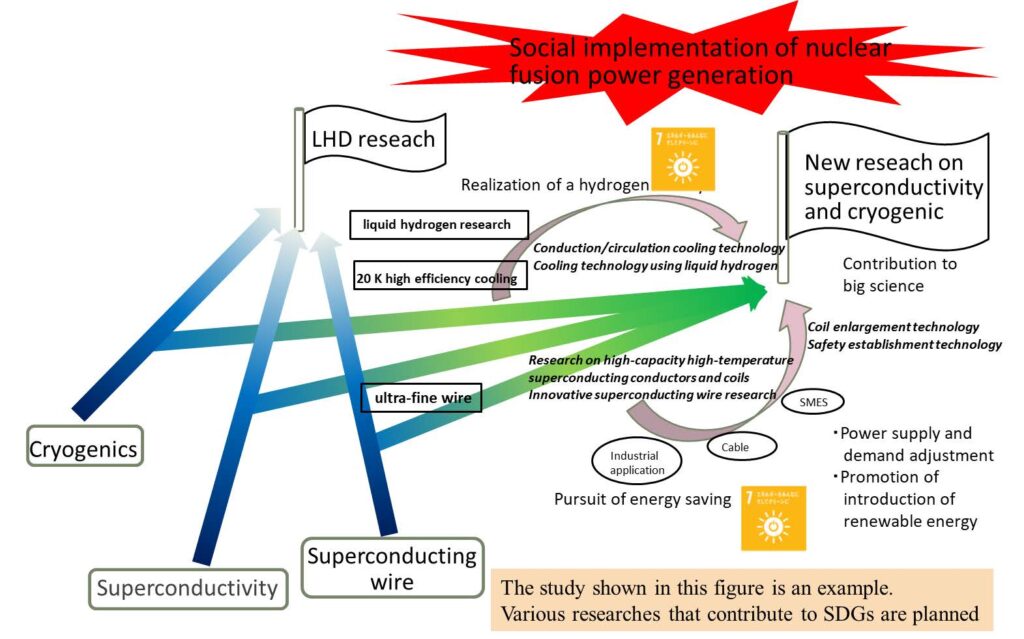Latest News
News List-
Research Summary
Based on research results related to superconductivity and cryogenics that the National Institute for Fusion Science has been working on so far, this unit is an attractive and versatile innovation that promotes not only nuclear fusion but also the construction of a zero-carbon society. We are doing the research to establish the elemental technology for operating a typical high-field large-scale superconducting magnet with high reliability. A wide range of superconducting materials, from metals to oxides and MgB2, is studied without particular limitation. As for the cooling method, various cooling methods including liquid hydrogen cooling are targeted. Based on the abundant research achievements so far, we will also challenge new research issues. For example, we plan to research and develop on large-capacity high-temperature superconducting coils, applied research on superconductivity using liquid hydrogen, research on advanced superconducting wires, and research on highly reliable inspection methods for superconducting wires and conductors.
As shown in Fig.1, by further activating the genes of superconductivity and cryogenic engineering specialized in nuclear fusion development cultivated through the LHD project and joint research with universities, it will become an accelerating driving force for the realization of a sustainable society. The goals of this unit is to develop new superconducting engineering and cryogenic engineering aiming at high safety and reliability, including “hydrogen”. On the other hand, high-performance superconducting materials are one of the important component materials of future nuclear fusion. Furthermore, from the viewpoint of energy conservation, they also have a higher affinity to contribute a SDG’s society. In order to promote the general use of superconducting materials, it is necessary to breakthrough their mechanically brittle and fragile properties. In this unit, therefore, we would like to study about the increase of the mechanical strength in a high-performance superconducting material based on the material science and engineering, and also realize “React and Winding” oriented superconducting wires in a future.

Fig.1 Goals of the Applied Superconductivity and Cryogenics Unit
Member
*:Unit Leader
-
Assoc. Prof. CHIKARAISHI, Hirotaka
-
Project Prof. CHIKUMOTO, TomokoAffiliate The University of Osaka
-
Assoc. Prof. HAMAGUCHI, ShinjiFields Cryogenics
-
Prof. HIRANO, Naoki
-
Assoc. Prof. HISHINUMA, Yoshimitsu
-
Prof. IMAGAWA, Shinsaku
-
Guest Assoc. Prof. KAWAGOE, AkifumiAffiliate Kagoshima University
-
Professional Staff MITO, Toshiyuki
-
Assoc. Prof. MIURA, Shun
-
Assoc. Prof. OBANA, TetsuhiroFields Applied Superconductivity
-
Assist. Prof. ONODERA, YutaFields Applied Superconductivity
-
Assist. Prof. TAKADA, SuguruFields Cryogenics
-
Prof. TAKAHATA, Kazuya
-
Guest Assoc. Prof. YAMAMOTO, AkiyasuAffiliate Tokyo Univ. of Agriculture and Technology
-
Prof. YANAGI, Nagato (Unit Leader)Fields Applied Superconductivity
-
Professional Staff YOSHIDA, Shigeru
External Member
-
AMEMIYA, NaoyukiAffiliate Kyoto University, Prof.
-
AWAJI, SatoshiAffiliate Tohoku University, Prof.
-
ISHIYAMA, AtsushiAffiliate Waseda University, Prof.Post Chairperson
-
ITO, SatoshiAffiliate Tohoku University, Assoc. Prof.
-
KAMIYA, KojiAffiliate NIMS, Deputy director
-
KAWAGOE, AkifumiAffiliate Kagoshima University, Assoc. Prof.
-
KIKUCHI, AkihiroAffiliate NIMS, Group Leader
-
KISU, TakanobuAffiliate Kyushu University, Senior Prof.
-
NISHIJIMA, GenAffiliate NIMS, Group Leader
-
OGURO, HidetoshiAffiliate Tokai University, Assoc. Prof.
-
OHYA, MasayoshiAffiliate Kwansei gakuin University, Assoc. Prof.
-
OKAMURA, TetsujiAffiliate Tokyo Inst. Tech., Prof.
-
TAKEDA, MinoruAffiliate Kobe University, Prof.
-
WANG, XudongAffiliate KEK, Assist. Prof.
-
YAGAI, TsuyoshiAffiliate Sophia University, Prof.
-
YOSHIDA, YutakaAffiliate Nagoya University, Prof.
Publications
Contact
Email:asc

